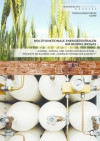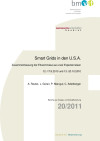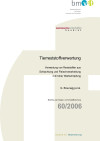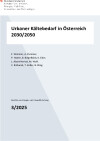Suchergebnisse für "Factsheet: Energietechnologien gestalten, die für alle sinnvoll und nutzbar sind"
Ausstellung: Baufamilien-Tag
25. April 2010
Harmannsteinerstraße
3922, Großschönau, AT
Der Sonnenplatz Großschönau veranstaltet am 25. April 2010 einen Baufamilien Tag. Dieses Mal zum Schwerpunktthema "Wärmepumpe".
Fachtagung: Wege zur klimaneutralen Kommune
30. September 2012
Landesmesse StuttgartStuttgart, DE
Fachtagung im Rahmen der CEP® CLEAN ENERGY & PASSIVEHOUSE
IEA Bioenergy Task 37: Report "Biogas production from kitchen wastes in Jinhua, China" (2021)

Der Report gibt eine Übersicht über ein erfolgreiches Beispiel zur Vergärung von Küchenabfällen in China.
Fang Ming
Herausgeber: IEA Bioenergy Task 37, 2021
Englisch, 4 Seiten
Downloads zur Publikation
Multifunktionale Energiezentralen am Beispiel Biogas

Wärme-, Strom- und Treibstoffproduktion - Projekte im Rahmen von "Energiesysteme der Zukunft"
1/2009
Herausgeber: BMVIT
Deutsch, 6 Seiten
Downloads zur Publikation
Smart Grids in den U.S.A.

Zusammenfassung der Erkenntnisse aus zwei Expertenreisen (12.-17.9.2010 und 13.-20.10.2010)
Schriftenreihe
20/2011
A. Reuter, L. Güran, P. Marxgut, C. Adenberger
Herausgeber: BMVIT
Deutsch, 38 Seiten
Downloads zur Publikation
Passive House Summerschool an der FH Technikum Kärnten
Workshop zum Entwerfen, Planen und Berechnen von Gebäuden im Passivhaus-Standard.
Blickpunkt Forschung 2023
04. Oktober 2023, 13:00 - 18:00 Uhr
TUthSky, Getreidemarkt 9, 1060 Wien
Zum nunmehr 9.Mal präsentieren Forschende der TU Wien anwendungsnahe Forschungsergebnisse aktueller Forschung. Dieses Jahr wird der Fokus auf Ansätze der Klimaresilienz gelegt.
Info-Veranstaltung: Baufamilien-Tag
25. Juli 2010
1. Europäisches Passivhausdorf zum Probewohnen
3922, Großschönau, AT
Der Sonnenplatz Großschönau veranstaltet am 25. Juli 2010 einen Baufamilien-Tag. Dieses Mal zum Schwerpunktthema "Sanierung mit Passivhauskomponenten".
Info-Veranstaltung: Baufamilien-Tag
27. Juni 2010
1. Europäisches Passivhausdorf zum Probewohnen
3922, Großschönau, AT
Der Sonnenplatz Großschönau veranstaltet am 27. Juni 2010 einen Baufamilien Tag. Dieses Mal zum Schwerpunktthema "Wohnraumlüftung".
Tierreststoffverwertung

Verwertung von Reststoffen aus Schlachtung und Fleischverarbeitung mit hoher Wertschöpfung
Schriftenreihe
60/2006
G. Braunegg et al.
Herausgeber: BMVIT
Deutsch, 100 Seiten
Downloads zur Publikation
IEA Bioenergy Task 40/Task 36: Transboundary flows of woody biomass waste streams in Europe (2019)

Der Bericht „Grenzüberschreitende Ströme von Holzbiomasseabfällen in Europa“ wird auf drei Seiten zusammengefasst.
Herausgeber: IEA Bioenergy Task 40
Englisch, 3 Seiten
Downloads zur Publikation
C3E Organizational Leadership and C3E Woman of Distinction Awards
Das neue IEA TCP "Clean Energy Education & Empowerment (C3E)" schreibt gemeinsam mit WiRE - Women in Renewable Energy zwei Awards aus.
Urbaner Kältebedarf in Österreich 2030/2050

Systematische Aufarbeitung des steigenden Kühlbedarfs und Darstellung der geographischen Verortung des Kältebedarfs in Österreich. Das Ergebnis dient als Entscheidungshilfe bei der Entwicklung von Klimaschutzmaßnahmen und Klimawandelanpassungsstrategien sowie eine Abschätzung zum Kältebedarf der Zukunft.
Schriftenreihe
3/2025
F. Wimmer, A. Pummer, P. Holzer, B. Beigelböck, K. Eder, L. Abart-Heriszt, M. Wolf, C. Rzihacek, T. Keller, B. Kling
Herausgeber: BMK
Deutsch, 91 Seiten
Downloads zur Publikation
GreenGEO - Data-based integration of climate change adaptation measures into spatial planning
Green and blue infrastructure (GBI) is a key instrument in the fight against climate change. Nevertheless, deciding where and in what form it should be used most effectively remains a challenge in spatial planning practice. The development of a digital model that links location-specific climate risk data with suitable GBI measure proposals will make this much easier and more objective.
IEA ISGAN Annex 2: Policy messages on Innovative Regulatory Approaches with Focus on Experimental Sandboxes to Enable Smart Grid Deployment (2019)

Aufgrund von ISGAN-Veranstaltungen auf der CEM9 in Kopenhagen hat das International Smart Grid Action Network (ISGAN) ein Projekt zum Wissensaustausch von Regulatory Sandboxes initiiert.
Helena Lindquist, Magnus Olofsson
Herausgeber: ISGAN Annex 2
Englisch, 3 Seiten
IEA AFC Annex 35: Steam reforming of bioethanol-gasoline mixtures (2018)

Dieser Abstract befasst sich mit der Reformierung von E85 Bioethanol zur Erzeugung von Synthesegas.
D. Ladenhaufen, K. Malli, V. Hacker
Herausgeber: Graz University of Technology, S. 27-28
Englisch
Downloads zur Publikation
IEWT 2013: 8. Internationale Energiewirtschaftstagung
13. - 15. Februar 2013
TU Wien, Karlsplatz 13Wien, AT
Erneuerbare Energien: Überforderte Energiemärkte?
Kongress: 10. schönauer Expertentage 2011
17. - 18. November 2011
Forschungs- und Kompetenzzentrum für Bauen und Energie
Sonnenplatz 1, 3922 Großschönau, AT
Wirtschaft - Innovation - Nachhaltigkeit: Energieeffizienz als globale Herausforderung
Fachexkursion Flandern: Programm am 12. September 2018
Tag 2 der Exkursion: Antwerpen - Over de Ring, Brüssel - Atelier Bouwmeister
Info-Veranstaltung: Baufamilien-Tag
28. Juni 2009
1. Europäisches Passivhausdorf zum Probewohnen
3922, Großschönau, AT
Der Sonnenplatz Großschönau veranstaltet am 28. Juni 2009 erneut einen Baufamilien Tag. Dieses Mal zum Schwerpunktthema "Luftdichtheit im Passivhaus".
